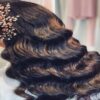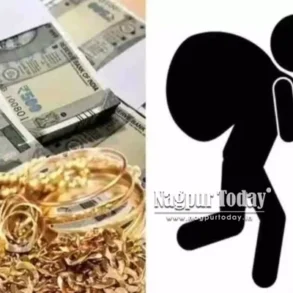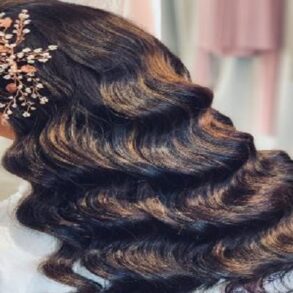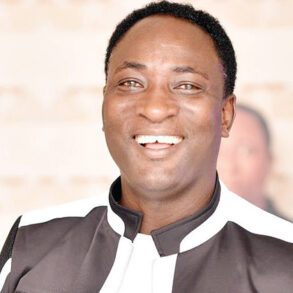BYUH students share how they express themselves, their fashions and their cultures through their hair
For Lolene Kacivi, Gracie Payne and Fryda Garcia Salgado, hair represents culture, fashion, personal expression, confidence and self-love.
“The way that we wear our hair changes throughout the years, and you find what makes you feel comfortable, confident and better,” said Garcia Salgado, a junior double majoring in intercultural peacebuilding and political science from Mexico. “So hair as fashion is not [about] doing your hair in the correct way. It’s the way that it makes you feel comfortable and empowered.”
Kacivi, an intercultural peacebuilding sophomore from Fiji, explained her hair represents her personal journey. “I cut my hair every time I start something new,” she said. “I let it grow out throughout the journey and then if I am moving on to something new, I’ll cut it again. It’s my way of recording my journey, of when I was in that space.”
“Hair is an identifier,” Kacivi added. “It [can and cannot] complete your look or it can make you question. If you look at Fijians, you can identify them by their Afro and its round in shape…Hair tells a story…Hair describes who you are. It says a lot about you.”
Payne, a sophomore from Virginia majoring in social science education, said hair is “a way to try out different styles to make your own.” With current fashions, she said, hair is a necessary accessory. Payne explained how versatile hair is, with the trendy options of dyeing it any color, doing braids or twists and straightening or curling it. She said certain outfits go well with certain hair looks.
Hair and culture
According to Payne, “I think hair is super important especially as a Black woman. For years we didn’t really know how to style [our natural hair].”
Payne explained beauty standards in society have not helped Black women have confidence in their hair. She shared experiences where she was uncomfortable because of comments from other people who would say things along the lines of, “I love your crazy hair! I love your poofy hair.”
“This isn’t crazy. This is just my hair,” Payne said. “It really bothered me because I have been getting [those comments] for as long as I can remember. Of course a 5 year old is going to [hear] that and think, ‘I have to wear it like everyone else does’.”
Payne said she now loves her hair. “I think it’s so much fun, especially discovering the right products and diffusers. It feels like such an accomplishment.” She said it took her a while to get to the point of loving her hair because she grew up in an environment where many people had straight hair, convincing her straight hair was the standard of beauty. Once she learned to love her natural hair, she said she loved discovering new ways to style and take care of it.
Garcia Salgado said hair has a lot of meaning in her culture. “In ancient times, pre-colonization, hair identified which tribe you were from and whether you were married or single and also for girls, it represented when they had their first period,” she explained. “It also showed fertility for girls who had long hair and the social and economic class you were in.”
As a Fijian, Kacivi said, “Hair is mana (power). We believe that the taller the hair, the more mana you have because it is where your power lies. So traditionally, Fijians would have these big Afros.” She remarked in the Fijian language, the words “kalou mana” represent both power and blessings.
In society and on social media, Garcia Salgado said she believes there is more versatility and representation for diverse hair types. “You can [now] see people with your type of hair doing different hairstyles that motivate you to do your own,” Garcia Salgado said.
Payne said she has noticed there is more representation of Black women’s hair in social media and society, even though there is still more work to do as far as representation goes. “We’re embracing more of the natural look, letting people just be who they are.”
Kacivi said social media and society are doing a good job of representing Fijian hair types. “There’s been a rise in appreciation for natural indigenous Fijian hair, now it’s [trending]. It’s nice to see girls back at home appreciating their hair and not [relaxing it].” She said on social media, she is seeing more representation through models, people from her island and family appreciating their natural beauty. Kacivi said her community is embracing their culture and letting go of insecurities.
Finding love for hair
Kacivi said she struggled but eventually found love and confidence in her hair. Kacivi’s hair was falling out due to the ingredients she was using in her hair products, she said, and so she has had to focus on finding the right kind of hair products and hair styles. After taking advice from her friend, she said she was able to find products to stop her hair loss and help her have a healthy and happy hair.
For Garcia Salgado, loving her hair has not always been easy, she said. She said she felt like an outsider because her sister and mother had curly hair while her hair was straight.
“I would cry because I wanted curly hair and I thought that I was ugly and different.” As she grew, Garcia Salgado said her hair changed from straight to “fluffy.”
She said this change caused her to struggle with self-confidence because her hair didn’t fit into a category of curly or straight.
As Garcia Salgado got older, she said her hair transitioned from fluffy to wavy and finally, to curly. She said she learned how to do her hair and eventually came to love her hair around the ages of 15-16.
Throughout high school, Payne said she felt like she needed to have her hair straight. “I was in a place … [with] mostly white people and so the beauty standard was straight hair. I was straightening my hair every day, and my hair was getting dry and damaged.”
She said she would wake up two hours earlier every morning to straighten her hair, until one day she decided to shave it. After she shaved her head, Payne said she cried for two weeks, but eventually felt liberated by the choice.
Payne explained how her mom motivated her and helped her love her natural hair. “I was adopted and my mom, she has all these books about how to style hair. It would be a step-by-step breakdown of how to do braids or get ringlet curls. She was really cute and she worked really hard.” Payne fondly recounted one of her favorite hairstyles her mom did for her included beads at the end of her braids.
Expression through hair
Garcia Salgado said, “I feel like with curly hair, everyone goes through a phase where they hate their hair because they do not know what to do with it. With hair, it’s about finding what looks good on you or what you like.” She said she now feels confident about her hair by doing hairstyles like French or Dutch braids, natural curls and two small ponytails which she twists while leaving the rest of her hair down.
“Hair is a way to express yourself…. It’s something very personal.You can follow trends, you can experiment to find what you are looking for,” she explained.
Garcia Salgado encouraged others to find expression and confidence in their hair, while using it as a way to uplift and find beauty in themselves.
Payne loves experimenting with her hair and finding new styles that can complement her hair, she said. “One of my favorite hairstyles right now is [by] pulling my hair back, putting it into a ponytail and flipping the hair back. It looks really voluminous.”
Payne said she enjoys seeing her hair in disarray when she wakes up, as it is funny to her and satisfyingly proves how well she slept the previous night. She also said her curls bring her joy.
Kacivi said her hair connects to her favorite person in the world, her grandfather. On the back of Kacivi’s head, she said she has what is similar to a widow’s peak, which her grandfather had as well. Though her grandfather passed away a few years ago, she said she still marvels at the connection she has with him. “They would call me after him because we both had … a little tail [at the back of our head]…They could call me and my grandfather ‘Taito,’” Kacivi recalled.
This post was originally published on this site be sure to check out more of their content.







